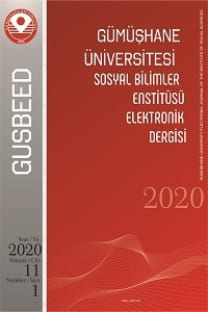Acil Durum ve Afetlere Müdahale Personelinin Kriz Anı Kurum İçi İletişimlerinin Değerlendirilmesi: Trabzon İli Örneği
Öz Araştırmanın amacı Acil Durum ve Afetlere Müdahale personelinin kriz anı kurum içi iletişim düzeylerinin belirlenerek, demograik değişkenlere göre anlamlı bir farklılığın olup olmadığının tespit edilmesidir. Elde edilecek bulgular vesilesiyle Acil Durum ve Afetlere Müdahale personelinin iletişim anlamındaki sorunları tespit edilerek daha etkin çalışmalarının önünün açılması hedeflenmektedir. Araştırma ölçeğinin ana başlığı “Kriz Anı Kurum İçi İletişim” olup 4 alt faktöre ayrılmıştır: ‘‘Kriz Anı Ekip İletişiminin Değerlendirilmesi’, ‘‘Kriz Anı Bireysel İletişim Aktivasyonunun Değerlendirilmesi’’, ‘‘İletişimsel Kriz Yönetim Planları Erişilebilirliğinin ve Bilinirliliğinin Değerlendirilmesi’’ ve ‘‘İletişimsel Kriz Yönetim Planlarının İşlevselliğinin Değerlendirilmesi”. Anket 6 adet demografik soruyu veya toplamda 23 adet Kriz Anı Kurum İçi İletişim ölçeğinin sorularını içermektedir. Araştırmada frekans, yüzde tabloları ve Mann-Whitney U testi kullanılmıştır. Araştırmanın evreni Trabzon’da görev yapan, Devlet Hava Meydanları İşletmesi, Afet ve Acil Durum Başkanlığı, Orman Bölge Müdürlüğü ve İtfaiyede (acil durum ve afetlere müdahalede görev yapan) çalışanlardır. Toplamda 103 personele ulaşılmış ve anket uygulanmıştır. Anket 28.11.2020-15.12.2020 tarihleri arasında gerçekleştirilmiştir. Kriz anı ekip iletişiminin farklı faktörler ve değişkenler açısından değişiklik gösterdiği bulunmuştur. Ayrıca, sorulara verilen cevapların demografik değişkenlere göre farklılık gösterip göstermediğine dair yapılan test sonucu cinsiyet değişkeni açısından 2 soru, medeni durum açısından 1 soru, kıdem değişkeni açısından 2 soru, yaş değişkeni açısından 2 soru, çalışılan kurum açısından 13 soru, ünvan değişkenine göre 6 soru farklılık göstermektedir.
Anahtar Kelimeler:
Afet, Afet İletişimi, Kriz, Kriz iletişimi
Evaluation of Internal Communications of Emergency and Disaster Response Personnel at the Time of Crisis: The Case of Trabzon Province
The aim of the study is to determine whether there is a significant difference according to demographic variables by determining the internal communication levels of the Emergency and Disaster Response personnel at the moment of the crisis. With the findings to be obtained, it is aimed to determine the communication problems of Emergency and Disaster Response personnel and to pave the way for more effective work. The main title of the research scale is “Internal Communication During Crisis” and it is divided into 4 sub-factors: “Evaluation of Crisis Team Communication”, “Evaluation of Crisis Individual Communication Activation”, “Evaluation of Accessibility and Awareness of Communicative Crisis Management Plans” and “Evaluating the Functionality of Communicative Crisis Management Plans”. The questionnaire includes 6 demographic questions or a total of 23 questions of the Internal Communication Scale of the Moment of Crisis. Frequency, percentage tables and Mann-Whitney U test were used in the study. The universe of the research is the employees working in the State Airports Administration, the Disaster and Emergency Presidency, the Regional Directorate of Forestry and the Fire Department (working in emergency and disaster response), working in Trabzon. A total of 103 personnel were reached and a questionnaire was conducted. The survey was conducted between 28.11.2020-15.12.2020. It has been found that team communication at the time of the crisis varies in terms of different factors and variables. In addition, the results of the test on whether the answers given to the questions differ according to demographic variables are 2 questions in terms of gender variable, 1 question in terms of marital status, 2 questions in terms of seniority variable, 2 questions in terms of age variable, 13 questions in terms of the institution where they work, 6 questions according to the title variable.
Keywords:
Disaster, Disaster Communication, Crisis, Crisis Commination.,
___
Becker, E. F., & Wortmann, J. (2009). Mastering communication at work: How to lead, manage, and influence. McGraw Hill Professional.Brataas, K. (2018). Crisis Communication: Case Studies and Lessons Learned from International Disasters. Routledge.
Choi, H., Park, J. A., & Kim, Y. (2019). Decreasing aggression through team communication in collegiate athletes. sustainability, 11(20), 5650.
Coombs, W. T. (1999). Ongoing crisis communication: Planning, managing, and responding, Sage.
Fearn-Banks, K. (2016). Crisis communications: A casebook approach. Routledge.
Givens, G. (1978). The non-verbal basis of attraction: flirtation, courtship and seduction, Psychiatry, 41: 346–359.
Kalaycı, Ş. (2010). SPSS uygulamalı çok değişkenli istatistik teknikleri (Vol. 5). Asil Yayın Dağıtım, Ankara.
Oral, V., & Turan, M. (2018). Social media use in disaster. International Journal of Scientific and Technological Research, 4(10), 275–286.
Perez, A. (2018). The Role of Law Enforcement-Community Communication in Disaster Readiness.
Taylor, M., & Kent, M. L. (2007). Taxonomy of mediated crisis responses. Public Relations Review, 33(2), 140-146.
Weimann, P., Hinz, C., Scott, E., & Pollock, M. (2010). Changing the communication culture of distributed teams in a world where communication is neither perfect nor complete. Electronic Journal of Information Systems Evaluation, 13(2), 187.
Yang, B. (2011). A comprehensive study of the chinese government's natural disaster communication framework based on the natural disaster management and communication system's response to two natural disasters. University of Southern, California. Zaremba, A. J. (2010). Crisis communication theory and practice. Armonk, NY: M.E. Sharper.
- ISSN: 1309-7423
- Yayın Aralığı: Yılda 3 Sayı
- Yayıncı: Gümüşhane Üniversitesi
Sayıdaki Diğer Makaleler
Yağmur KARADAĞ, İlknur AYDOĞDU KARAASLAN
Mekân Tasarımı Üzerine Sistematik Bir Süreç Araştırması
Gamze DEMİRCİ, Burçin Cem ARABACIOĞLU
Münevver ÇETİN, Mürüvvet KARTAL BAŞ
Neo-Realist Perspektiften Doğu Akdeniz ve Enerji Güvenliği
Gümüşhane Dölek Köyü’nde Çarksız Çömlekçiliğin Kültürel Coğrafyası: Adaptasyon, Kültür ve Ekoloji
Makyavelizmin Öğretim Üyelerinin Karar Verme Stilleri Üzerindeki Etkisi: Nicel Bir Araştırma
Kamu Çalışanlarının Kapsayıcı Liderlik Algısı Üzerine Bir Araştırma
Evlilik Doyumu ve İş Tatmini Arasındaki İlişkinin Mükemmeliyetçilik Aracı Rolü ile İncelenmesi
